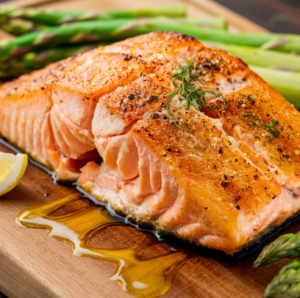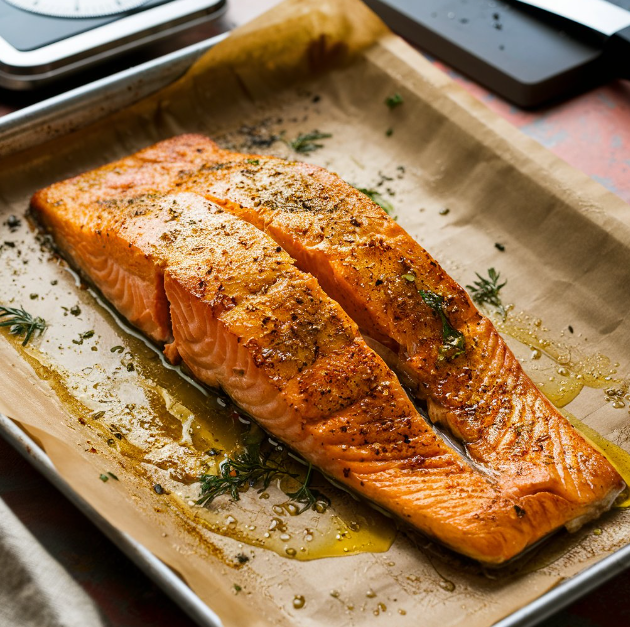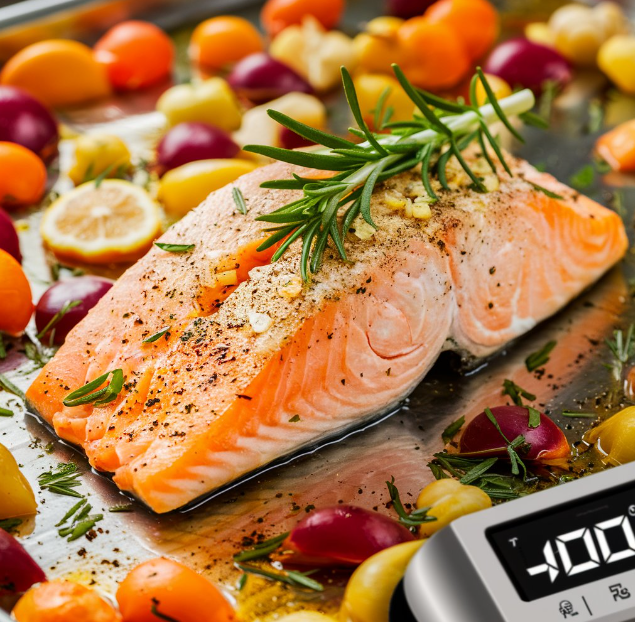In today’s culinary landscape, salmon stands out not only for its health benefits but also for its versatility in cooking methods. One common question among home cooks is about how long to bake salmon at 400 degrees. This article will guide you through the perfect timing, preparation, and cooking techniques to ensure your salmon is both delicious and nutritious. We’ll explore everything from prepping the fish to pairing it with side dishes, answering all your pressing questions along the way. So, let’s dive into the art of baking salmon effectively at 400 degrees!
Introduction to Baking Salmon at 400 Degrees
Baking salmon at a consistent 400 degrees Fahrenheit strikes a perfect balance between speed and tenderness, making it a favorite method for many. The key to mastery, however, lies in the details—from selecting the right type of salmon to understanding how slight variations in preparation can impact your final dish.
Choosing the Right Type of Salmon
When planning to bake salmon, the choice of salmon is pivotal. Options like Sockeye, Coho, or King salmon each bring their unique flavors and textures. Generally, wild-caught salmon is preferred for its richer flavor and firmer texture, but farmed Atlantic salmon is more readily available and also yields tasty results.
Necessary Ingredients and Tools
To get started, you’ll need a few basic ingredients and tools:
- Fresh salmon fillets
- Olive oil or a light brushing of melted butter
- Seasonings like salt, pepper, and optional herbs like dill or parsley
- A baking sheet, preferably lined with parchment paper for easy cleanup
Pre-baking Preparation Steps
Before you pop the salmon into the oven, ensure it’s prepped correctly to optimize cooking:
- Preheat your oven to 400°F to ensure it reaches the right temperature by the time you’re ready to bake.
- Pat the salmon dry with paper towels. Removing excess moisture helps achieve a beautifully seared top.
- If your fillet has skin, place it skin-side down on the baking sheet. The skin will crisp up nicely, providing a delightful texture contrast.
- Lightly oil and season your salmon. This not only adds flavor but also helps keep it moist and tender during baking.
With your salmon prepped and your oven humming along at the right temperature, you’re all set to bake. This simple yet effective approach sets the stage for a delicious meal that’s both satisfying and healthy. Remember, using the right techniques can transform your home-cooked salmon into a dish you’d be proud to serve at any dinner party. In the next section, we’ll delve deeper into the baking process, ensuring your salmon is cooked just right every time.
Detailed Guide to Baking Salmon at 400 Degrees
Mastering the baking of salmon at 400 degrees Fahrenheit involves understanding the nuances of time and temperature. This section provides a step-by-step guide to ensure your salmon turns out perfectly every time you bake it.
Step-by-Step Baking Instructions
- Preparation: Place your prepared salmon on the lined baking sheet. If you’re using additional flavorings like lemon slices or a sprinkle of brown sugar, add these on top of the fillets now.
- Baking: Slide the baking sheet into the preheated oven. It’s crucial to place it in the middle rack to promote even cooking.
How Long to Bake Based on Thickness
The thickness of your salmon fillets will dictate the total baking time:
- Thin fillets (about 1/2 inch thick) typically take about 10 minutes.
- Thicker fillets (up to 1 inch) might need closer to 15 minutes.
An easy rule of thumb is to bake the salmon for 10-15 minutes per inch of thickness, checking towards the lower end to avoid overcooking.
Tips for Even Cooking
- Consistency is key: Try to select fillets that are uniformly thick so they cook evenly.
- Don’t overdo it: Keep an eye on the oven as salmon cooks quickly and can go from perfect to overdone in a matter of minutes.
- Use a thermometer: For those who prefer precision, an instant-read thermometer should read 145°F when inserted into the thickest part of the fillet for a fully cooked, safe-to-eat salmon.
By following these detailed steps, you can bake salmon that is moist on the inside with a deliciously tender flake. Perfecting this method will not only impress your guests but also allow you to enjoy a healthy meal that is high in omega-3 fatty acids and low in fat. Up next, we’ll explore how to elevate your baked salmon with various seasoning and marinade options that will take the flavor to the next level.
Enhancing Your Baked Salmon
Once you’ve mastered the basic technique of baking salmon at 400 degrees, the next step is to enhance its flavor and presentation with various seasonings, marinades, and accompaniments. This section explores how to add a gourmet touch to your simple baked salmon.
Seasoning Varieties
Experimenting with different seasonings can transform the flavor profile of your salmon. Here are some popular options:
- Classic: A simple seasoning of salt and freshly cracked black pepper is timeless.
- Herb-infused: Sprinkle chopped dill, parsley, or basil for a fresh, herby taste.
- Sweet and savory: A light dusting of brown sugar mixed with garlic powder adds a delightful contrast.
Using Marinades and Glazes
Marinades and glazes not only add flavor but also help keep the salmon moist and tender during baking:
- Citrus zest: Marinade the salmon with lemon or orange zest mixed with olive oil a few hours before baking to infuse it with a bright, acidic flavor.
- Maple-soy glaze: Combine maple syrup and soy sauce for a sweet and savory glaze that caramelizes beautifully in the oven.
Accompaniments and Side Dishes
The right side dishes can complement and enhance the main course:
- Light salads: A simple green salad or a cucumber-dill salad pairs well with the richness of salmon.
- Grains: Serve with quinoa, brown rice, or farro for a hearty and healthy meal.
- Vegetables: Roasted asparagus, sautéed spinach, or grilled zucchini make for vibrant, nutritious options.
By incorporating these elements into your meal, you can elevate a basic baked salmon into a more complex and enjoyable dining experience. Engaging in culinary creativity not only enhances the flavors but also brings a personal touch to every dish you serve. In the next section, we will look at how to handle common baking issues to ensure your salmon is perfect every time.
Troubleshooting Common Issues
Baking salmon seems straightforward, but occasionally, you might encounter some hitches that affect the outcome. This section addresses common problems and offers practical solutions to ensure your salmon is perfectly cooked every time.
Avoiding Overcooking
Overcooking salmon can lead to a dry, tough texture:
- Watch the clock: Adhering to the recommended time of 10-15 minutes per inch of thickness is crucial.
- Check doneness early: Start checking the salmon a few minutes before the timer goes off to prevent overcooking.
Managing Undercooked Centers
Undercooked salmon can be just as problematic:
- Even thickness: Purchase cuts that are uniformly thick to ensure even cooking.
- Adjust placement in oven: If the edges cook faster, you might need to move the salmon to a lower rack in the oven.
Addressing Uneven Thickness
Uneven thickness can cause some parts to cook faster than others:
- Folding thinner parts: You can fold under the thinner parts of the fillet to match the thickness of the rest of the piece.
- Separate cooking times: Consider cutting the fillet into uniform pieces and cooking them separately if necessary.
These troubleshooting tips will help you navigate potential pitfalls and achieve perfectly baked salmon. Remember, every oven is a bit different, so take the time to learn how yours works with various dishes. Coming up next, we’ll explore alternative methods to baking salmon that can provide different flavors and textures to suit any occasion.
Alternatives to Bake Salmon at 400
While baking salmon at 400 degrees is a popular and effective method, exploring alternative cooking techniques can add variety to your meals and allow you to enjoy different flavors and textures.
Grilling Salmon
Grilling salmon is a fantastic way to add a smoky flavor to the fish:
- Preparation: Lightly oil the grill and the salmon to prevent sticking.
- Technique: Place the salmon skin-side down on the grill and cover. Cook for 6-8 minutes, depending on thickness, without flipping.
Using an Air Fryer
For a quicker and crispier finish, the air fryer is an excellent alternative:
- Setup: Preheat the air fryer to 400 degrees. Place the salmon in the basket, skin-side down.
- Cooking Time: Air fry for about 7-10 minutes. This method is great for achieving a slightly crispier exterior.
Slow Roasting Techniques
Slow roasting is ideal for enhancing the salmon’s natural flavors and achieving an exceptionally tender texture:
- Temperature: Set your oven to 275 degrees Fahrenheit.
- Duration: Slow roast the salmon for about 15-20 minutes. This method is particularly good for larger or thicker fillets.
Each of these methods provides a unique way to cook salmon, offering versatility in your culinary repertoire. Whether you’re in the mood for the smoky taste of grilled salmon, the quick convenience of an air fryer, or the succulent tenderness of slow-roasted salmon, these alternatives ensure that you can always keep your meals exciting and delicious. Up next, we’ll look at how to effectively utilize FAQs to address common queries and enhance the usefulness of your article on baking salmon.
To keep the salmon moist and fresh, it’s best to encase it snugly in plastic wrap or place it within a sealed container. This approach helps to lock in moisture and maintain the salmon’s flavor until you’re ready to enjoy it again.
Conclusion
Perfecting Your Salmon Baking Technique
Mastering the art of baking salmon at 400 degrees is a culinary skill that promises not only delicious meals but also healthy dining options for you and your family. From selecting the right salmon cut to exploring various seasoning and cooking methods, we’ve covered a broad range of techniques to help you enhance every aspect of your salmon preparation.
As we’ve explored in this guide, the key to perfect salmon lies in paying attention to cooking times, seasoning properly, and complementing your fish with the right sides. By avoiding common cooking pitfalls and utilizing alternative cooking methods, you can keep your salmon dinners exciting and varied.
Remember, the ultimate goal is to cook salmon that is flavorful, moist, and flaky. Whether you are preparing a quick weeknight dinner or a special meal for guests, these tips and techniques will empower you to bake salmon to perfection every time.
Experiment with the tips and recipes provided, and continue to refine your approach based on the flavors and textures that you and your family enjoy the most. Happy cooking, and enjoy your perfectly baked salmon!
Frequently Asked Questions
Addressing frequently asked questions is a helpful way to provide additional insights and tips on baking salmon. Here, we’ll tackle some common queries that might arise when preparing salmon in the oven.
How long should I bake a salmon fillet at 400 degrees?
For most salmon fillets, the optimal baking time at 400 degrees Fahrenheit is between 12 to 15 minutes. However, the exact time can vary based on the thickness of the fillet. A general rule is to bake for 10-15 minutes per inch of thickness.
What are the signs that salmon is done baking?
Can I bake salmon without foil?
Yes, you can bake salmon without foil, which allows the edges to get a bit crisper. However, using foil can help keep the moisture in and make clean-up easier. If you choose not to use foil, consider using a silicone baking mat or parchment paper.
How can I make sure my baked salmon is flavorful?
To ensure your salmon is flavorful:
- Marinate: Soaking the salmon in a marinade for a few hours before cooking can infuse it with more depth of flavor.
- Season well: Don’t skimp on seasoning. For an enhanced flavor, blend various herbs and spices with a good sprinkle of salt and pepper. This mix will help to bring out the salmon’s natural richness and create a more complex taste profile.
- Add fats: Adding olive oil or a pat of butter before baking can help enhance the flavor and texture of the salmon.
These FAQs not only help in solving common issues but also in enhancing the overall cooking experience, ensuring that your salmon dishes turn out flavorful and perfectly cooked every time.



